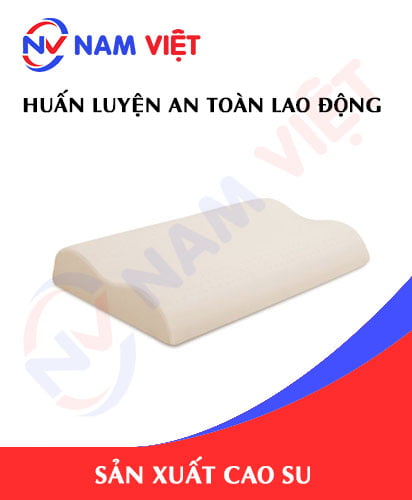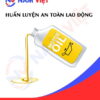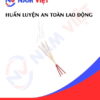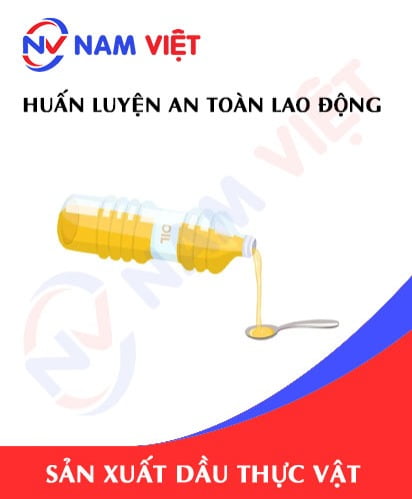Occupational Safety Training for Rubber Manufacturing
99,000 ₫
Note: The above price is calculated for one person, the price may fluctuate depending on the number of trainees participating in the course and the market movement. For more accurate price support, please refer to the price list or contact our consulting staff directly.
Occupational safety is an important issue in factory manufacturing rubber and needs to be addressed promptly to ensure the health and safety of workers, enhancing the reputation of businesses. The Occupational Safety Training course is one of the effective solutions to raise awareness of how to prevent occupational accidents for workers participating in rubber manufacturing.
Table of Contents
Toggle1. Overview of Rubber
a. What is Rubber?
- Rubber is a natural or synthetic material with elastic, stretchable, wear-resistant, high-temperature resistant, and chemical-resistant properties. It is mainly produced from native rubber trees in tropical regions such as Brazil, Indonesia, Malaysia, Thailand, and Vietnam. Rubber can also be produced from other sources such as petroleum or artificial synthetic rubbers. Rubber is widely used in industrial products, especially in tire manufacturing, belts, hoses, and other rubber products.
- The rubber manufacturing industry in Vietnam is one of the rapidly growing sectors in recent years. Vietnam is among the leading rubber producers in the world, accounting for 3% of global rubber output. However, Vietnam’s rubber production is mainly natural rubber, while synthetic rubber only accounts for a small proportion. In 2021, Vietnam was expected to produce 1.2 million tons of rubber, an increase of 8.8% compared to the previous year.
- Currently, rubber manufacturing in Vietnam is mainly concentrated in the western provinces and the Central Highlands, with leading companies including Vietnam Rubber Group, Long Thanh Rubber Company, Dong Phu Rubber Joint Stock Company, Eastern Rubber Joint Stock Company, etc.
- Technologies in rubber production are also continuously being developed and improved to increase productivity and product quality. At the same time, the rubber industry faces challenges such as a lack of highly skilled labor and fluctuations in global market prices.

b. Types of Rubber Manufacturing Machinery
Rubber is an important material widely used in various fields, from automotive and household goods to medical equipment. To produce rubber products, rubber manufacturing companies need to use the following machines:
- Rubber milling machine: used to grind rubber blocks into powder for easier processing later.
- Rubber compression machine: used to press rubber powders into rubber sheets or other desired shapes.
- Rubber injection molding machine: used to create products by injecting rubber into molds.
- Rubber calendering machine: used to press rubber sheets into products of desired thickness.
- Rubber cutting machine: used to cut rubber sheets into different sizes for further processing and production.

c. Typical Rubber Manufacturing Companies
Typical rubber manufacturing companies in Vietnam include:
- Vietnam Rubber Industry Group (VRG) – the largest corporation in Vietnam for rubber production and business, managing the country’s rubber production system with 19 subsidiaries nationwide.
- Da Nang Rubber Joint Stock Company (DRC) – one of Vietnam’s leading rubber manufacturers, specializing in products such as tires, rubber hoses, rubber pads, rubber sheets, vibration dampers, bearings, conveyors, etc.
- Viet Thang Rubber Company Limited (VRC) – specializes in producing products such as rubber hoses, rubber sheets, rubber pads, bearings, conveyors, and other rubber products.
- Duy Tan Rubber Company Limited (DUTA) – specializes in producing rubber products such as rubber pads, vibration dampers, oil seals, rubber hoses, rubber sheets, bearings, conveyors, and other rubber products.
- Southern Rubber Joint Stock Company (CASUMINA) – a leading company in producing and trading rubber products such as tires, rubber hoses, rubber pads, rubber sheets, and other rubber products.
- Binh Duong Rubber Joint Stock Company (BSR) – specializes in rubber products such as rubber hoses, rubber pads, rubber sheets, bearings, conveyors, and other rubber products.
- Hoang Gia Rubber Company Limited (HR) – specializes in rubber products such as rubber hoses, rubber sheets, rubber pads, oil seals, coupling seals, conveyors, and other rubber products.
d. Specific Jobs in a Rubber Manufacturing Factory
Group 1
- Executive director, deputy executive director, department heads in the rubber manufacturing factory.
Group 2
- Safety officers: manage factory safety, design safety procedures, supervise and ensure employees follow safe work processes.
Group 3
- After purchasing raw materials, workers will carry out rubber production, including steps such as grinding, mixing chemical compounds, vulcanization, rolling products, cutting products, and quality inspection.
- Maintenance and repair: Maintenance staff ensure the proper operation of factory equipment to produce high-quality rubber. In case of malfunctions, they repair and maintain the equipment.
- Packing and transportation: After production, rubber products are packed and prepared for delivery to customers or distributors.
Group 4
- Office work, service, sales, and marketing.
- Production management: The management team ensures smooth production and high-quality rubber products. They supervise production activities, control product quality, and make decisions on production policy and personnel, etc.
- Quality management, human resources management, materials management, financial and accounting management.
- Design safe production procedures and technology suitable for modernizing rubber manufacturing factories.
- Raw material procurement: Employees purchase materials such as rubber trees and chemical compounds for rubber production.

2. Overview of Rubber Manufacturing Occupational Safety Training Course
In this article, we focus on issues related to Group 3 because Group 3 is directly involved in the production process and faces the highest occupational safety risks. For reference to other groups, see here.
a. What is Group 3 Occupational Safety Training?
- Group 3 occupational safety training consists of sessions that equip workers with awareness of how to prevent occupational accidents.
- The training course helps workers identify and prevent hazards, reducing the risk of occupational accidents during work.
REGISTER FOR OCCUPATIONAL SAFETY TRAINING SERVICE
b. Training Duration
Initial occupational safety training duration
- Total training time is at least 24 hours, including examination time.
- 8 hours of theory on safety policies, laws, and occupational hygiene.
- 8 hours of theory on basic knowledge of occupational safety and hygiene.
- 4 hours of theory on specialized training content.
- 2 hours of practice on specialized training content.
- 2 hours of theoretical examination at the end of the training course.
The training center will divide the training into multiple sessions depending on the employee schedule. Typically, there are 6 training sessions over 3 days if the company arranges continuous study time.
Periodic occupational safety training
- Before the occupational safety card expires, workers who want to renew it must undergo periodic occupational safety training with periodic training duration of at least 50% of the initial training duration.
Explanation: The total periodic occupational safety training time is at least 12 hours, including examination time. After completing the periodic training and passing the test, workers will be reissued or have their occupational safety card extended.
c. Training Course Content
| No. | TRAINING CONTENT | TRAINING TIME (HOURS) | |||
| Total | Including | ||||
| Theory | Practice | Examination | |||
| I | Safety policies and laws on occupational hygiene | 8 | 8 | 0 | 0 |
| 1 | Overview of legal documents system on occupational safety and hygiene. | 6 | 6 | ||
| 2 | System of standards and technical regulations on occupational safety and hygiene. | 1 | 1 | ||
| 3 | Specific regulations of state management agencies on occupational safety and hygiene when constructing, expanding, or renovating facilities for production, use, storage, and inspection of machines, equipment, materials, and substances with strict occupational safety and hygiene requirements. | 1 | 1 | ||
| II | Basic knowledge of occupational safety and hygiene | 8 | 8 | 0 | 0 |
| 1 | Basic knowledge of hazards and harmful factors at the workplace. | 4 | 4 | ||
| 2 | Methods to improve working conditions. | 1 | 1 | ||
| 3 | Safety culture in production and business. | 1 | 1 | ||
| 4 | Rights and obligations of employers and employees; occupational safety and hygiene policies for workers; roles and duties of safety officers. | 1 | 1 | ||
| 5 | Occupational safety and hygiene rules, safety signs, instructions, use of safety equipment and personal protective equipment; first aid skills for accidents, prevention of occupational diseases. | 1 | 1 | ||
| III | Specialized training content | 6 | 4 | 2 | 0 |
| Comprehensive knowledge of machines, equipment, substances generating hazards; risk analysis, assessment, and management of occupational safety; safe work procedures with machines, equipment, and substances with strict safety requirements. | 6 | 4 | 2 | ||
| IV | Final examination of occupational safety training | 2 | 2 | 0 | 0 |
| Total | 24 | 22 | 2 | ||
See more training content of 6 groups
d. Occupational Safety Card
After completing the occupational safety training course and passing the test, workers will be issued a occupational safety card (commonly called occupational safety certificate for Group 3).
The Group 3 safety card shows information such as: full name, date of birth, specific job and working environment, training duration, red seal, and signature confirming completion of the training course.
According to the card issuance regulations in Clause 2 of Article 24, Decree 44/2016/ND-CP, there are two cases:
- If the employer and employee have a labor contract, the employer must sign, stamp, and validate the safety card for Group 3 trainees after completing the training and passing the test.
- If the worker is freelance or temporary, without a labor contract, the training unit must sign, stamp, and validate the safety card after the worker completes the training and passes the test.

3. Identifying Hazards in Rubber Manufacturing
During rubber manufacturing, there are many potential risks that may endanger workers. Some main hazards include:
- During rubber manufacturing, workers may be exposed to toxic chemicals such as phthalate compounds, benzene, lead, and manganese, which can harm health causing cancer, pneumonia, neurotoxicity, and adverse effects on the cardiovascular and digestive systems.
- Rubber factories often use machinery and equipment to process rubber into various products. When rubber is heated to melt, there is a risk of burns causing serious injuries to workers.
- Machinery and equipment in rubber factories can cause serious occupational accidents if not operated properly or maintained regularly.
- Rubber factories often need to handle and dispose of waste and unused products. Handling and transporting these materials can pollute the environment and affect the health of workers and surrounding communities.
- During rubber manufacturing, workers must perform tasks such as transporting, loading, and using heavy tools and equipment. Performing these tasks improperly or without sufficient training can lead to physical injuries.
4. Common Occupational Accidents in Rubber Manufacturing
Rubber is an important material in many industrial and manufacturing sectors. However, rubber manufacturing also poses many hazards to workers. Some common occupational accidents include:
- Crushing, injuries, or loss of hands due to being caught or crushed by manufacturing machinery and equipment.
- Burns or scalds caused by contact with chemicals such as acids, alkalis, molten rubber, and high-temperature liquids.
- Inhalation of rubber dust, fumes, or toxic vapors causing lung disease, throat inflammation, nasal irritation, breathing difficulties, eye irritation, vomiting, and headaches.
- Punctures or cuts from tools, knives, or other objects during manufacturing.
- Falls, slips, or trips when moving on uneven or slippery surfaces.
- Burns from contact with hot surfaces or equipment.
- Injuries from transporting and moving rubber products.
- Electric shocks when working with electrical equipment in the rubber factory.
5. Safety Measures in Rubber Manufacturing
Safety measures when participating in rubber manufacturing include:
- Machinery must be maintained regularly to ensure proper operation and prevent unexpected malfunctions.
- Employees should use protective equipment such as helmets, steel-toe shoes, gloves, safety glasses, and masks to safeguard themselves while working.
- Toxic chemicals used in rubber manufacturing must be handled safely and minimized. Employees should be trained to safely use hazardous chemicals.
- Ensure that products are transported safely and properly to prevent leaks or accidents.
- Employees should receive occupational safety training and learn safe work procedures to ensure they have the knowledge and skills to work safely.
- Waste from manufacturing must be properly treated to avoid harming the environment and human health.
- Factories should conduct regular safety inspections to ensure that equipment, systems, and procedures operate safely.
- Periodically carry out workplace environment monitoring in factories, collect and analyze harmful factors for workers, and adjust to reduce hazards to prevent occupational diseases.

6. Benefits of Occupational Safety Training in Rubber Manufacturing
An Toan Nam Viet provides your business with the following benefits after completing occupational safety training courses in accordance with Decree 44/2016/ND – CP on occupational safety and hygiene for companies, factories, and enterprises:
- Workers can recognize potential occupational hazards and take preventive measures to avoid accidents.
- Your company can establish risk prevention measures in manufacturing, operation, and maintenance processes.
- Reduce costs associated with potential occupational hazards.
- Uninterrupted manufacturing processes help increase labor productivity and product quality.
- Compliance with occupational safety laws, avoiding legal risks.
- Create prestige and professionalism in all aspects, enhancing your company’s brand.
Nam Viet training courses are a solution to prevent external risks that could lead to injury or even death.
REGISTER FOR OCCUPATIONAL SAFETY TRAINING SERVICE
7. Customer Feedback After Completing Rubber Manufacturing Safety Training
An Toan Nam Viet has years of experience supporting businesses across Vietnam, particularly in southern provinces. This responsibility is highly valued by Nam Viet, and thus our Occupational Safety Training has become increasingly professional. The motivation for Nam Viet’s growth comes from both positive feedback and constructive suggestions from enterprises. Below are feedback from partners we have served.
Bac Nam E&C Investment and Construction Joint Stock Company
“The first time I used An Toan Nam Viet’s service, I was surprised by the 24/7 support from their consulting team. The class organization was fast and convenient for our company. Thank you very much for Nam Viet’s service!”
See more customer interviews after using the service of An Toan Nam Viet
8. Occupational Safety Training Capacity of An Toan Nam Viet
An Toan Nam Viet is a reputable and quality occupational safety training center in Vietnam. Training sessions are continuously held at factories, manufacturing plants, or construction sites nationwide (63 provinces in Vietnam).
REGISTER FOR OCCUPATIONAL SAFETY TRAINING SERVICE
License for occupational safety training
- An Toan Nam Viet has been inspected and certified by the Department of Safety under the Ministry of Labor – Invalids and Social Affairs, granting a certificate of eligibility for occupational safety and hygiene training. This further strengthens our occupational safety training capability.

Training Materials and Lectures
- Before occupational safety training materials are applied in ATLĐ courses, they are reviewed to ensure knowledge accuracy and practical effectiveness.
- Instructors’ teaching methods are standardized according to An Toan Nam Viet standards, developed by experts in occupational safety and hygiene training to maximize learners’ knowledge absorption.
Facilities
- Controlling classroom factors affecting training increases teaching efficiency and learners’ knowledge absorption.
- Our training facilities include spacious classrooms meeting standards for area, lighting, and training equipment.
9. Nationwide Reputable and Quality Safety Training Center
At An Toan Nam Viet, we always prioritize the professional dedication to occupational safety training. For us, imparting knowledge on self-protection to workers so that they have a safe journey in their livelihood contributes to building the nation.
To ensure effective training, we meticulously prepare every detail, no matter how small. From preparing teaching tools, equipment, and devices to curricula, materials, audio, and lighting.
Our occupational safety trainers are experts with many years of experience in the field. They even have research projects on identifying hazards in all industries and methods to prevent them.
Lectures are distilled from practical experience and delivered in the most vivid, easy-to-understand way for workers. These elements help workers feel comfortable during learning and effectively absorb the knowledge taught. Of course, the knowledge imparted always adheres to Decree 44/2016/ND-CP.
Thus, workers understand many hazard prevention measures and how to protect themselves. At the same time, they can apply them appropriately in real work situations.
Our Safety Training Center is proud to provide professional and reputable occupational safety training services with the following advantages:
- Competitive training costs while ensuring training quality.
- Flexible training schedules to suit the production situation of your company.
- Quick and legally compliant procedures for issuing occupational safety training certificates.
- Trainers with extensive professional experience.
- Classrooms are controlled for factors affecting training, improving teaching efficiency and learners’ knowledge absorption.
- Lectures are tailored to occupational safety tasks in enterprises.
- An Toan Nam Viet works dedicatedly and professionally to support clients accurately and quickly.

10. Additional Reference Materials for Occupational Safety Training in Rubber Manufacturing
- Occupational Safety Materials for Rubber Manufacturing
- Occupational Safety Training Materials Set
- Occupational Safety Training Test Set
- Rubber Manufacturing Occupational Safety Quiz
- Slides for Occupational Safety Training in Rubber Manufacturing
11. Activities in Occupational Safety Training for Rubber Manufacturing
1 review for Occupational Safety Training for Rubber Manufacturing
No comments yet















namchinh.haiphong341
giảng viên dạy rất sinh động dễ hiểu!